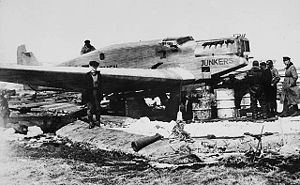Bremen (aircraft)
| Bremen | |
|---|---|
 |
|
| "Bremen" after the transatlantic crossing | |
| Type | Junkers W 33 |
| Construction number | 2504 |
| Registration | D-1167 |
| Fate | Preserved |
| Preserved at | Bremen Airport Museum |
The Bremen is a German Junkers W 33 aircraft that made the first successful transatlantic aeroplane flight from east to west between April 12 and 13, 1928.
The Bremen left Baldonnel Aerodrome, Ireland, on April 12 and flew to Greenly Island, Canada, arriving on April 13, after a flight fraught with difficult conditions and compass problems. The crew consisted of pilot Captain Hermann Köhl, the navigator, Major James Fitzmaurice, and the owner of the aircraft, Ehrenfried Günther Freiherr von Hünefeld.
When the sun disappeared and the clouds obscured the stars, the Bremen climbed to 6,000 feet (1,800 m). Köhl estimated that they were then about three hours from land. If they had been able to stay on course, his estimate would have proven to have been correct. In fact, without the aid of the north star, they then relied on a magnetic compass and drifted far off course toward the north.
When the Bremen landed on Greenly Island, the first Canadian aircraft to reach the scene was piloted by Duke Schiller and the second machine was flown by the Canadian Transcontinental Airways Company's Chief Pilot, Romeo Vachon, who arrived two days later with a group of media representatives. Both Schiller and Vachon were flying Fairchild FC-2W machines; G-CAIQ (Schiller) and G-CAIP (Vachon). Gretta May Ferris, a nurse from Saint John, New Brunswick, who was posted at nearby Forteau's Grenfell Medical Station, travelled by dogsled some 15 miles (24 km) to attend to the crew's medical needs; she was the first to write the story that was picked up by the international media saying that the Bremen had landed and that the crew were safe.
The clock in the lighthouse was remembered (by the family of the lighthouse keeper) as indicating 2 p.m. Atlantic Time when the Bremen was first sighted from the ground. Captain Köhl and Baron von Hünefeld said that they were in the air 36½ hours. If their statements of elapsed time had an accuracy of better than one minute, which is unlikely, then the time of touchdown was 18:08 GMT or 13:08 EST or 14:08 Atlantic Time.
...
Wikipedia
